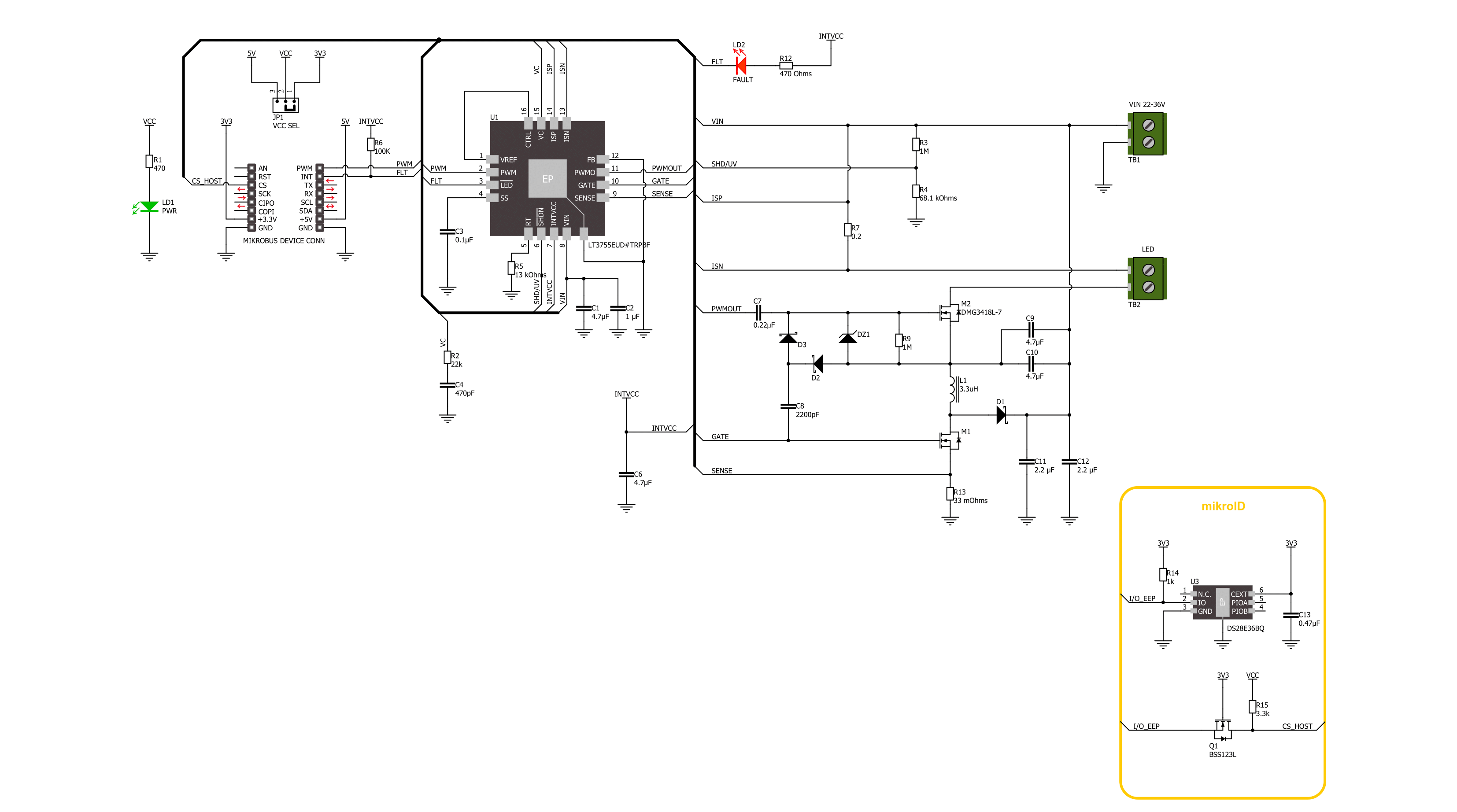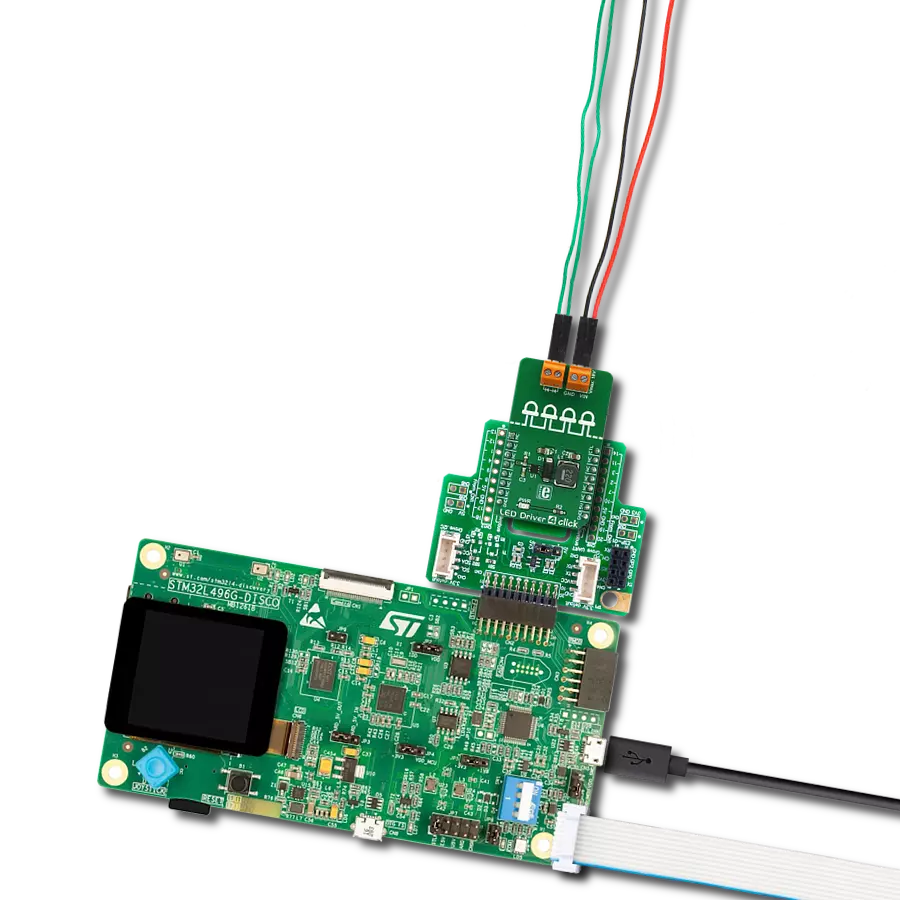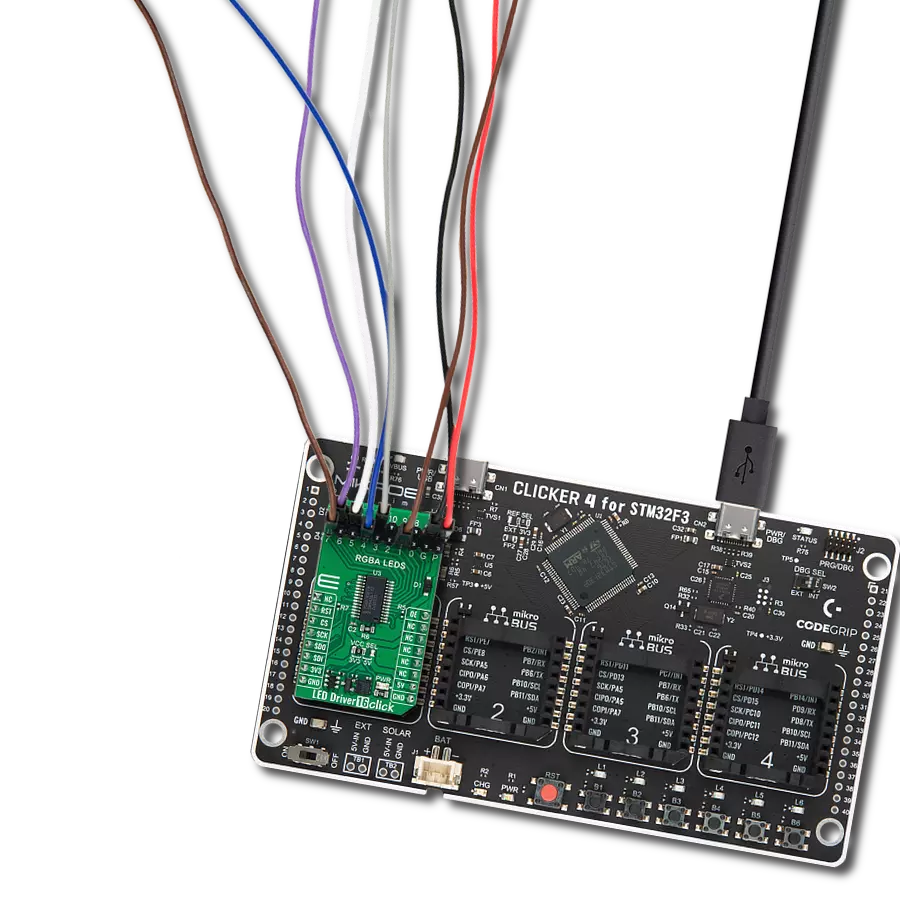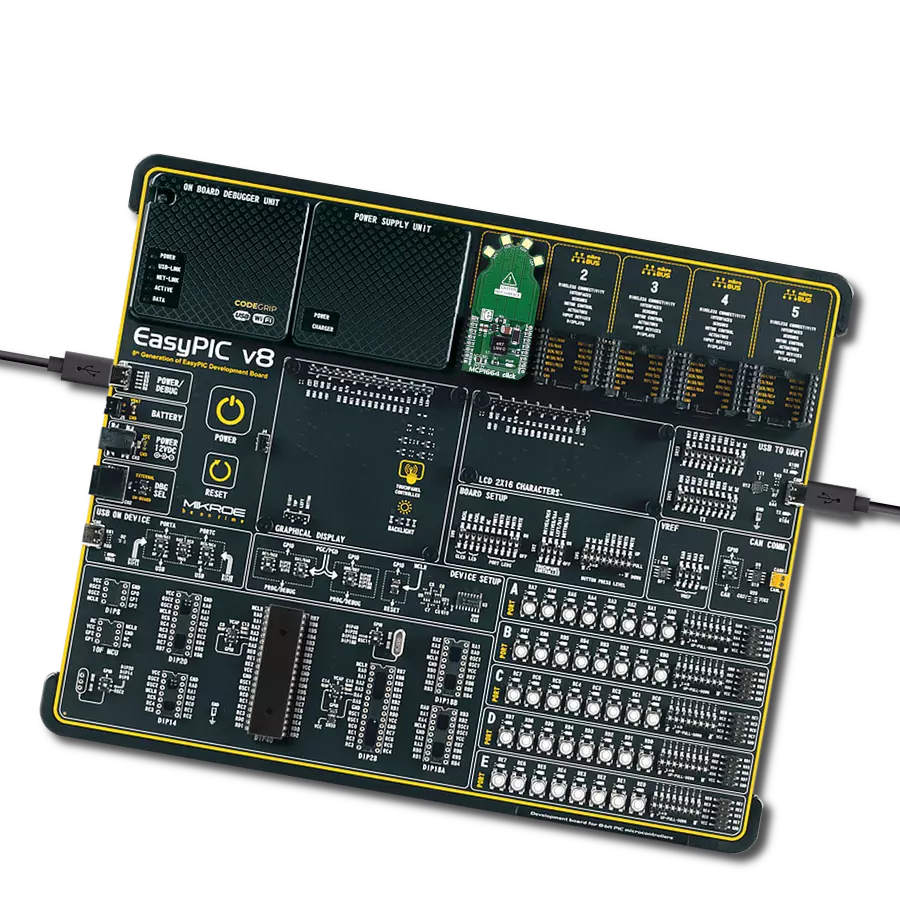With our LED driver solution, you can count on uninterrupted, reliable performance, guaranteeing that your lighting systems are always on when needed.
A
A
Hardware Overview
How does it work?
LED Driver 17 Click is based on the LT3755, a highly efficient DC/DC controller from Analog Devices. This Click board™ is designed as a Buck mode LED driver with the ability to output 500mA, offering, in addition, PWM dimming functionality. The LTR3755, a highly efficient DC/DC controller, operates as a constant-current source and features onboard low-side external N-channel power MOSFETs, which are driven from an internal regulated supply and are capable of driving high-power 16V LEDs. Due to its high efficiency and reliable protection features, this board can be used in applications that require consistent and precise LED lighting control. It can also be used in applications that demand high power output,
such as commercial and industrial lighting. In terms of connectivity, this solution is designed to be controlled via the PWM pin of the mikroBUS™ socket to provide LED dimming control with ratios of up to 3000:1. In addition, the LT3755 also has a frequency adjust pin that allows the user to program the switching frequency from 100kHz to 1MHz. This feature is performed via an onboard R5 resistor, with the 800kHz set as the default value to optimize efficiency and performance. Other than the PWM pin, this Click board™ also features a fault pin labeled FLT, which is routed to the default interrupt INT position of the mikroBUS™ socket. This fault pin indicates any fault conditions to an external system, including overvoltage and
overcurrent protection. Besides information via the mikroBUS™ socket, the fault signal is visually indicated via a red LED labeled LD2. This LED Driver 17 Click supports an external power supply for the driver, which can be connected to the input terminal labeled VIN and should be within the range of 22V to 36V. This Click board™ can operate with either 3.3V or 5V logic voltage levels selected via the VCC SEL jumper. This way, both 3.3V and 5V capable MCUs can use the communication lines properly. Also, this Click board™ comes equipped with a library containing easy-to-use functions and an example code that can be used as a reference for further development.
Features overview
Development board
PIC18F57Q43 Curiosity Nano evaluation kit is a cutting-edge hardware platform designed to evaluate microcontrollers within the PIC18-Q43 family. Central to its design is the inclusion of the powerful PIC18F57Q43 microcontroller (MCU), offering advanced functionalities and robust performance. Key features of this evaluation kit include a yellow user LED and a responsive
mechanical user switch, providing seamless interaction and testing. The provision for a 32.768kHz crystal footprint ensures precision timing capabilities. With an onboard debugger boasting a green power and status LED, programming and debugging become intuitive and efficient. Further enhancing its utility is the Virtual serial port (CDC) and a debug GPIO channel (DGI
GPIO), offering extensive connectivity options. Powered via USB, this kit boasts an adjustable target voltage feature facilitated by the MIC5353 LDO regulator, ensuring stable operation with an output voltage ranging from 1.8V to 5.1V, with a maximum output current of 500mA, subject to ambient temperature and voltage constraints.
Microcontroller Overview
MCU Card / MCU

Architecture
PIC
MCU Memory (KB)
128
Silicon Vendor
Microchip
Pin count
48
RAM (Bytes)
8196
You complete me!
Accessories
Curiosity Nano Base for Click boards is a versatile hardware extension platform created to streamline the integration between Curiosity Nano kits and extension boards, tailored explicitly for the mikroBUS™-standardized Click boards and Xplained Pro extension boards. This innovative base board (shield) offers seamless connectivity and expansion possibilities, simplifying experimentation and development. Key features include USB power compatibility from the Curiosity Nano kit, alongside an alternative external power input option for enhanced flexibility. The onboard Li-Ion/LiPo charger and management circuit ensure smooth operation for battery-powered applications, simplifying usage and management. Moreover, the base incorporates a fixed 3.3V PSU dedicated to target and mikroBUS™ power rails, alongside a fixed 5.0V boost converter catering to 5V power rails of mikroBUS™ sockets, providing stable power delivery for various connected devices.
Used MCU Pins
mikroBUS™ mapper
Take a closer look
Click board™ Schematic

Step by step
Project assembly
Track your results in real time
Application Output
1. Application Output - In Debug mode, the 'Application Output' window enables real-time data monitoring, offering direct insight into execution results. Ensure proper data display by configuring the environment correctly using the provided tutorial.

2. UART Terminal - Use the UART Terminal to monitor data transmission via a USB to UART converter, allowing direct communication between the Click board™ and your development system. Configure the baud rate and other serial settings according to your project's requirements to ensure proper functionality. For step-by-step setup instructions, refer to the provided tutorial.

3. Plot Output - The Plot feature offers a powerful way to visualize real-time sensor data, enabling trend analysis, debugging, and comparison of multiple data points. To set it up correctly, follow the provided tutorial, which includes a step-by-step example of using the Plot feature to display Click board™ readings. To use the Plot feature in your code, use the function: plot(*insert_graph_name*, variable_name);. This is a general format, and it is up to the user to replace 'insert_graph_name' with the actual graph name and 'variable_name' with the parameter to be displayed.

Software Support
Library Description
This library contains API for LED Driver 17 Click driver.
Key functions:
leddriver17_get_fault_pin- This function returns the fault (FLT) pin logic state.leddriver17_set_duty_cycle- This function sets the PWM duty cycle in percentages ( Range[ 0..1 ] ).
Open Source
Code example
The complete application code and a ready-to-use project are available through the NECTO Studio Package Manager for direct installation in the NECTO Studio. The application code can also be found on the MIKROE GitHub account.
/*!
* @file main.c
* @brief LED Driver 17 Click example
*
* # Description
* This example demonstrates the use of LED Driver 17 Click board by changing
* the LEDs dimming level.
*
* The demo application is composed of two sections :
*
* ## Application Init
* Initializes the driver and performs the Click default configuration.
*
* ## Application Task
* Changes the LEDs dimming level by setting the PWM duty cycle every 500ms.
* The duty cycle percentage will be displayed on the USB UART. It also checks
* the fault indication pin and displays it accordingly.
*
* @author Stefan Filipovic
*
*/
#include "board.h"
#include "log.h"
#include "leddriver17.h"
static leddriver17_t leddriver17;
static log_t logger;
void application_init ( void )
{
log_cfg_t log_cfg; /**< Logger config object. */
leddriver17_cfg_t leddriver17_cfg; /**< Click config object. */
/**
* Logger initialization.
* Default baud rate: 115200
* Default log level: LOG_LEVEL_DEBUG
* @note If USB_UART_RX and USB_UART_TX
* are defined as HAL_PIN_NC, you will
* need to define them manually for log to work.
* See @b LOG_MAP_USB_UART macro definition for detailed explanation.
*/
LOG_MAP_USB_UART( log_cfg );
log_init( &logger, &log_cfg );
log_info( &logger, " Application Init " );
// Click initialization.
leddriver17_cfg_setup( &leddriver17_cfg );
LEDDRIVER17_MAP_MIKROBUS( leddriver17_cfg, MIKROBUS_1 );
if ( PWM_ERROR == leddriver17_init( &leddriver17, &leddriver17_cfg ) )
{
log_error( &logger, " Communication init." );
for ( ; ; );
}
if ( LEDDRIVER17_ERROR == leddriver17_default_cfg ( &leddriver17 ) )
{
log_error( &logger, " Default configuration." );
for ( ; ; );
}
log_info( &logger, " Application Task " );
}
void application_task ( void )
{
static int8_t duty_cnt = 1;
static int8_t duty_inc = 1;
float duty = duty_cnt / 10.0;
if ( !leddriver17_get_fault_pin ( &leddriver17 ) )
{
log_printf( &logger, " Fault detected!\r\n" );
}
leddriver17_set_duty_cycle ( &leddriver17, duty );
log_printf( &logger, " Duty: %u%%\r\n\n", ( uint16_t ) ( duty_cnt * 10 ) );
Delay_ms ( 500 );
if ( 10 == duty_cnt )
{
duty_inc = -1;
}
else if ( 0 == duty_cnt )
{
duty_inc = 1;
}
duty_cnt += duty_inc;
}
int main ( void )
{
/* Do not remove this line or clock might not be set correctly. */
#ifdef PREINIT_SUPPORTED
preinit();
#endif
application_init( );
for ( ; ; )
{
application_task( );
}
return 0;
}
// ------------------------------------------------------------------------ END
Additional Support
Resources
Category:LED Drivers


































